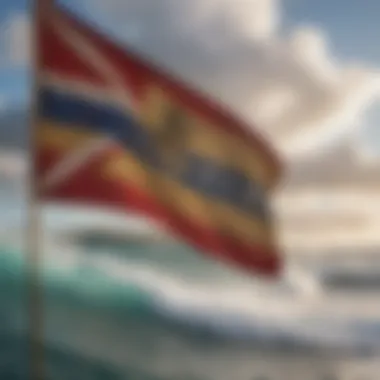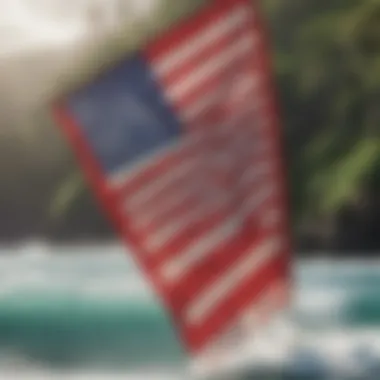The Hawaiian Banner: Cultural Significance and History


Intro
The Hawaiian banner represents not just a piece of fabric flapping in the breeze, but a vivid tapestry of history, identity, and cultural pride woven through the generations. Its colors and symbols echo the narrative of the islands, showcasing the spirit of a people deeply connected to their land and traditions. In the modern world, as globalization threatens to dilute many unique cultures, the Hawaiian banner stands as a resilient emblem, reminding us of the importance of preserving heritage.
Through this exploration, we will embark on a journey that highlights critical aspects surrounding the Hawaiian banner. We will dive into its historical roots, dissect its intricate craftsmanship, and discuss the values it embodies in Hawaiian society today. By creating a deeper understanding of this emblem, we hope to inspire a renewed appreciation for Hawaiian traditions and their relevance in today's context.
This article will provide insights not just into the banner's physical attributes but also its symbolic meanings, making clear that it's more than just a pretty sight. It’s a declaration of survival, resilience, and the ongoing journey of the Hawaiian people.
Stay tuned as we unpack layers of history, culture, and meaning tied to this majestic symbol.
Prologue to the Hawaiian Banner
The Hawaiian banner holds a unique position in both historical and contemporary contexts, symbolizing the identity and cultural heritage of the Hawaiian people. This article delves into the many facets of the banner, from its storied past to its ongoing significance in various cultural practices today. Exploring the narrative behind the banner is not merely an academic exercise; rather, it serves to weave together the threads of history, culture, and identity, offering a richer understanding of what it means to belong to a community steeped in tradition.
Historical Context
Understanding the historical roots of the Hawaiian banner is like peeling back layers of an intriguing onion. Each layer reveals a different facet of the Hawaiian islands, their history, and the people who inhabit them. Originally, the flags of the Hawaiian Kingdom played a crucial role in expressing sovereignty and independence during the 19th century. King Kamehameha I established flags that mirrored both the influences from foreign powers and the native cultural identity. These flags often featured bright colors, patterns, and symbols that resonated with the spiritual and physical connection the Hawaiians had to their land.
The Hawaiian flag has been transformed through various political and social upheavals. It's not just a piece of cloth; it’s a representation of a rich, often tumultuous history that has shaped the current socio-political landscape in Hawaii. At one point, the flag served as a means of diplomatic communication with nations like the United States and Great Britain. This nuanced interaction is essential for understanding the banner’s place in Hawaiian society today.
Symbolism in Hawaiian Culture
The symbolism embedded within the Hawaiian banner is profound and multifaceted. For the Hawaiian people, every element of the banner—colors, patterns, and even the materials—has a specific meaning, almost like a visual language that speaks to the viewer.
- Colors: The colors red, white, and blue are prominent, reflecting both Hawaiian and Western influences. The red symbolizes the strength and vitality of the Hawaiian people, while white stands for purity and peace. The blue not only connects with the vast Pacific Ocean but also emphasizes the importance of water in Hawaiian life.
- Cultural Imagery: Patterns in the banner may include representations of traditional Hawaiian motifs, such as the stylized representations of the ‘ai‘ai or the palm fronds, both of which tie back to agricultural sustainability and the harmony between the people and their environment.
- Resilience: Underlying all these elements is the spirit of resilience. The banner has become a beacon of hope and a powerful emblem for movements advocating for Hawaiian sovereignty and cultural preservation.
The Hawaiian banner is not just a sign; it is a collective memory, deeply interwoven with the narrative of a people who continue to navigate the complexities of identity in an ever-changing world. It calls on both locals and visitors alike to reflect on their connection to this land, its stories, and the legacies that shape them.
The Craftsmanship Behind the Banner
The craft involved in creating Hawaiian banners is more than just a skill; it’s an art that resonates with the rich history and cultural significance of Hawaii. Each banner is a reflection of the values and beliefs of the community, representing not only aesthetic beauty but also a profound connection to cultural identity. The importance of craftsmanship is paramount, as it touches on various aspects of heritage, resourcefulness, and sustainability. For the Hawaiian people, the making of these banners is not merely about fabric and design; it's about narrating stories that endure through generations.
Materials Used
When discussing the materials used for crafting Hawaiian banners, one must acknowledge the diversity of resources available in the islands. Traditionally, banners were made from natural fibers. Fiber from the ti leaf and bark cloth (kapa) were commonly utilized. Kapa is particularly noteworthy; it is derived from the bark of trees and often dyed with natural pigments sourced from local plants, representing the colors of the environment—from deep ocean blues to lush greens. Moreover, cotton became more prevalent after contact with Europeans, allowing artisans to experiment with various designs and styles.
Durability and connection to nature are at the core of material selection. Artists often select materials that stand the test of time against the elements, yet still are easy to manipulate into intricate designs when the occasion calls. For a banner to hold its place during hula performances or public ceremonies, it must be crafted with both strength and grace.
For instance, when making the official flag of Hawaii, the artisans sometimes blend cotton with synthetic fibers, ensuring both resilience and vibrancy in the prints. Such choices demonstrate a careful balance between tradition and adaptation, encapsulating the evolution of Hawaiian identity over centuries.
Traditional Techniques
Crafting Hawaiian banners involves techniques that have been handed down through generations. Each method is steeped in tradition and offers a glimpse into the ways of life of the Hawaiian people. One such technique is freehand sewing, where artisans painstakingly stitch intricate patterns that often symbolize various elements of the Hawaiian landscape, such as waves, mountains, and flora.
Another notable technique is block printing. This method allows artisans to reproduce specific designs accurately, a crucial aspect when banners are made for large cultural events. Often crafted from carved wood or stone, these blocks are used to transfer ink designs onto the fabric, resonating with the community's values.
Hand-dyeing is a cherished practice that brings vibrancy to the finished product. Utilizing natural dyes from sources like kukui nuts and berries, makers create captivating hues unique to the Hawaiian Islands. This not only ensures a connection to the land but also promotes sustainability in art creation.
"Craftsmanship is not only about the product but also about preserving the stories and traditions within every stitch."
In sum, the craftsmanship behind the Hawaiian banner represents a weaving together of materials, techniques, and stories that highlight an essential aspect of Hawaiian culture. From the selection of vibrant, regional materials to the meticulous crafting techniques used, each banner is a testament to the heritage and the innovative spirit of the Hawaiian people.
Hawaiian Flags and Their Evolution
The evolution of Hawaiian flags is not simply a tale of fabric and colors; it unfolds like an intricate tapestry woven with a rich history that speaks volumes about identity, sovereignty, and cultural integrity. Over the years, these banners have undergone significant transformations influenced by an array of domestic and foreign powers, each leaving an indelible mark on the Hawaiian flag's narrative. As we dive into this evolution, it becomes clear that these flags are far more than mere symbols. They capture the essence of a people striving to define their identity amidst changing tides.
Influences from Foreign Powers
Hawaii's position in the Pacific put it on the map for various foreign powers, causing a rift in traditional practices and allowing outside influences to reshape the flag's representation. From the arrival of Captain James Cook in the late 18th century to the establishment of a kingdom that would eventually be overthrown, the interactions with these powers have profoundly affected the flags of Hawaii.


- Initially, the Kamehameha I era flag showcased an eclectic mix, pulling in aspects from British naval flags, which were a reflection of the state's early dealings with England.
- The adoption of the Union Jack aligned Honolulu with colonial power dynamics, marking a shift from a purely indigenous identity to one increasingly enmeshed with outside influences.
- Fast-forward to the late 19th century, the Hawaiian Kingdom embraced its own identity by mainitaining a flag that showcased its royal lineage and its position among global powers. The flag from this time, featuring eight horizontal stripes symbolizing the major islands of Hawaii, stood as a bold proclamation of its sovereignty.
These flags marked significant stages in Hawaiian history and represented a constant tug-of-war between independence and external pressure. The historical significance of these flags cannot be overstated, as they are tangible reminders of a turbulent but formative period in Hawaii’s past.
Modern Adaptations
In the contemporary realm, Hawaiian flags have morphed again, yet this evolution brings a deeper appreciation for what these banners embody. With an increase in cultural pride and activism, the flags now serve a dual purpose—symbolizing the dilute inheritance from colonial times while propelling forward a narrative replete with resonating values.
The modern adaptations of the Hawaiian flag are often deeply intertwined with movements for sovereignty and social equity.
- Symbol of Resistance: Many activist groups utilize the Hawaiian flag in protests, asserting that its presence represents unresolved issues tied to colonialism and statehood debates.
- Cultural Festivals: The flag is a cornerstone during festivals, adorned with unique artwork that reflects local traditions and stories. From the hula dancers to the surf competitions, its use in these settings illustrates a unique blend of modern Hawaiian culture infused with historical significance.
- Art and Design: Designers are reinterpreting the flag in merchandise and home decor items, allowing Hawaiians off island to express their roots in creative ways. It's no longer confined to public buildings; it’s now a point of pride in homes and on clothing.
As the flag continues to evolve, it symbolizes more than heritage—it's a beacon for future generations. Reflecting on its journey, the Hawaiian flag is a testament to the people’s resilience and commitment to preserving their unique identity in an interconnected world.
"The Hawaiian flag is not just a piece of cloth. It’s a symbol of endurance, heritage, and hope for future generations."
The Hawaiian Banner in Events and Ceremonies
The Hawaiian banner, rich in history and meaning, plays an integral role in events and ceremonies across the islands. From joyous celebrations to solemn rites, this emblem serves more than just a decorative purpose; it becomes a living symbol of cultural identity, heritage, and community. In this section, we will delve into the cultural significance of the Hawaiian banner in various festivals and its vital role in traditional ceremonies and rites.
Cultural Significance in Hawaiian Festivals
When it comes to festivals in Hawaii, the Hawaiian banner is often proudly displayed, signaling unity and reverence for the past. Events such as the Merrie Monarch Festival, which honors hula, demonstrate how deeply intertwined the banner is with Hawaiian cultural expression. During such festivities, the banner embodies the spirit of celebration and the connection to ancestral roots.
The colorful design and motifs of the Hawaiian banner can evoke feelings of nostalgia among attendees who remember their family's histories or local tales associated with their specific symbols. As families gather, the banner not only serves as a visual centerpiece but also acts as a conversation starter, igniting discussions about heritage, traditions, and the importance of passing down these practices to future generations.
- Key Benefits of the Hawaiian Banner in Festivals:
- Fosters a sense of community among participants.
- Promotes awareness and appreciation of Hawaiian cultural traditions.
- Serves as a visual reminder of historical narratives and artistic practices.
"The Hawaiian banner is not just a piece of cloth; it is a tapestry of stories that connect us to our roots, binding generations together."
Role in Ceremonies and Rites
In many traditional ceremonies, the Hawaiian banner takes on an even more solemn significance. It acts as a marker of respect during rites of passage, including births, weddings, and funerals. The banner is often draped over altars or held by participants, serving to honor the occasion and elevate the sacredness of the event.
For instance, at a wedding, the presence of the banner can symbolize the joining of two families, as well as represent the couple's commitment to maintaining cultural values. It creates a tangible link between the couple and the ancestors, reminding everyone of the importance of lineage and the responsibilities tied to their heritage.
- Functions of the Hawaiian Banner in Ceremonies:
- Acts as a symbol of respect and honor for the occasion.
- Represents unity and connection among family members.
- Preserves traditional practices and teachings through generations.
The versatility of the Hawaiian banner allows it to seamlessly blend into various events while retaining its core message: a steadfast connection to culture and identity. As ceremonies unfold with the banner present, its presence amplifies the importance of rituals, thus playing a crucial part in Hawaii's cultural tapestry.
Contemporary Uses of the Hawaiian Banner
The Hawaiian banner is not merely a relic of the past; it holds substantial relevance in today’s world. Its contemporary uses reflect both the profound cultural identity of Hawaiians and their ongoing engagement with broader societal issues. In this section, we will explore how this vibrant emblem of heritage serves as a powerful symbol in various modern contexts, enriching our understanding of current Hawaiian life and identity.
Emblems of Identity
For many Hawaiians, the banner stands as a compelling representation of cultural identity. Beyond being a visually striking artifact, it embodies the narrative of resilience and history of the Hawaiian people. When individuals display the Hawaiian banner, it often signifies a deeper connection to their ancestry and a commitment to preserving their unique heritage.
Sharing the banner during community events, like luaus or hula festivals, cultivates a sense of belonging. It's about connecting generations; the elders share stories while the youth learn the significance behind the colors and symbols.
- The colors of the banner hold specific meanings:
- Red: symbolizes war and a sense of protection.
- White: signifies peace and the spirit of aloha.
- Blue: represents the ocean, essential to Hawaiian identity and sustenance.
In recent years, artist collaborations have further popularized the Hawaiian banner, with local designers creating clothing lines and home decor infused with its motifs. This artistic expression is more than just commerce; it's a celebration and reflection of identity that resonates both locally and globally.
Political and Social Movements


The Hawaiian banner also plays a pivotal role in various political and social movements. Activists have utilized its imagery to promote causes surrounding land rights and cultural sovereignty. It has become a rallying symbol for those advocating for the preservation of native Hawaiian culture in the face of significant external pressures from globalization and tourism.
During protests or community meetings, you can often see demonstrators waving the banner, signaling unity and purpose. Such visibility communicates a message loud and clear: the Hawaiian people continue to stand firm in their fight for recognition and rights.
"The Hawaiian banner is not just cloth; it’s a piece of our soul and our shared history."
Recent instances include the continued struggle for recognition of the native Hawaiian nation and efforts to stop unauthorized land developments. These movements emphasize the need for sustainable practices that respect both the land and the culture it supports.
Environmental Concerns and Cultural Preservation
The preservation of the Hawaiian banner is not solely about cultural identity; it intertwines with pressing environmental issues. The creation of banners traditionally involves materials sourced from the local environment, such as leaves, fibers, and dyes, which showcase the rich natural resources of Hawaii. However, unsustainable practices, along with environmental degradation, threaten these materials, making it crucial to approach banner creation with a mindful consideration of ecology.
Sustainable practices in creating Hawaiian banners not only honor the traditions of the past but also ensure future artisans can continue this cherished craft. This encompasses responsible harvesting methods that do not over-exploit the environment. When craftspeople use natural resources judiciously, they demonstrate respect for the land and its ecosystems, fostering a balance between cultural expression and environmental stewardship.
Sustainable Practices in Banner Creation
The revival of sustainable practices is vital in the creation of Hawaiian banners. Artisans are turning to locally sourced materials, often using both biodegradable fabrics and natural dyes taken directly from the landscape. For instance:
- Bamboo: This renewable resource is becoming a favored material due to its strength and flexibility. It is often used in the frames of banners.
- Dyes from Plants: Dyes derived from natural sources, such as (mountain plants), create vibrant colors often preferred over synthetic dyes. This not only ensures that the materials are eco-friendly but also that they link the banners directly to the Hawaiian environment.
By employing these methods, artisans contribute to the preservation of their cultural heritage while safeguarding their environment.
Initiatives for Cultural Preservation
There is a growing consciousness about the need to protect and preserve Hawaiian culture, including the art of banner-making. Various initiatives have emerged to both educate the younger generations and promote traditional practices. For example:
- Workshops: Organizations often hold workshops that teach the techniques of traditional banner-making, ensuring these skills are passed down. This hands-on approach engages community members and fosters a collective responsibility towards cultural preservation.
- Educational Programs in Schools: Some schools in Hawaii have developed curricula that incorporate local history and art, allowing students to learn not only the technique of banner making but also its significance in Hawaiian identity.
Additionally, online platforms and social media channels are becoming invaluable tools for sharing knowledge and celebrating Hawaiian culture. They serve as channels for cultural expression and awareness, allowing for a wider audience to appreciate and advocate for the preservation of these important traditions.
"In honoring and preserving our past, we empower our future. The Hawaiian banner serves not just as a symbol of identity but as a reminder of the cycles of nature and culture intertwined."
In summary, the intersection of environmental considerations and cultural preservation is vital for the future of Hawaiian banners. By sticking to sustainable practices and supporting initiatives that educate and engage, the Hawaiian community can ensure that this cherished emblem endures for generations to come.
The Hawaiian Banner as a Teaching Tool
The Hawaiian banner is much more than a piece of fabric; it serves as a sincere reflection of the Hawaiian culture and history. It plays a vital role in education, as it is used to convey the rich storytelling tradition of the islands. Through various educational programs, the banner helps bridge gaps between generations, allowing both the young and the old to connect with their heritage in meaningful ways. This aspect of the Hawaiian banner not only fosters cultural awareness but also empowers individuals to appreciate the values encapsulated within.
Educational Programs and Workshops
Numerous educational programs and workshops dedicated to the Hawaiian banner exist across the islands. These initiatives are essential for preserving the unique cultural landscape of Hawaii. Organizations often hold community workshops to teach the basics of the banner's creation, exploring everything from its historical significance to the storytelling woven into its design.
- Hands-On Activities: Participants engage in hands-on activities, like fabric dyeing and sewing, to create mini banners, simulating the traditional techniques handed down through generations.
- Cultural Insights: Workshops typically include discussions on the stories and meanings behind the symbols used on the banner. For instance, when a young learner threads their needle, they also thread history, learning about social structures, significant events, and the intricate relationship to the land.
- Community Collaboration: Local artisans often collaborate with these programs, providing authenticity. They share personal stories and the historical contexts behind each thread, enriching the educational experience.
These learning experiences not only teach crafting skills but also encourage participants to reflect on their heritage and identity. Through this, the Hawaiian banner becomes a medium for nurturing pride among the local community.
Learning through Design and Art
Artistic endeavors often find a home in the narrative of the Hawaiian banner. By allowing students to engage creatively, the banner transforms into a canvas of cultural expression. Students can explore colors, patterns, and symbols that represent their stories and values.
- Exploring Symbolism: Educators emphasize understanding the significance of various designs and how they relate to Hawaiian mythology, nature, and identity. This creative exploration metamorphoses abstract concepts into vibrant realities.
- Art Projects: Crafting projects can include painting and digital design, enabling learners to experiment with different mediums. This opens the possibility for contemporary interpretations of the traditional banner.
- Exhibitions: Community exhibitions showcase students’ artistic interpretations. These events promote dialogue about cultural themes, making the learning process much richer.
"The beauty of the Hawaiian banner lies in its ability to tell a story, to bridge the past and the future. It evolves just as the culture does."
Ultimately, the Hawaiian banner, through various educational avenues, serves not just as a teaching tool but as a vessel carrying the legacy of the Hawaiian people forward into future generations.
Global Influence of the Hawaiian Banner
The Hawaiian banner's reach extends far beyond the shores of its origin, influencing various facets of global culture. Understanding its global impact requires an exploration into its representation within popular culture and how tourism, often fueled by this cultural emblem, has contributed to its wider acceptance and recognition.


Representation in Popular Culture
Popular culture serves as a mirror to societal values and traditions. The Hawaiian banner has found its way into movies, music, and art, symbolizing not only Hawaii but also a more profound connection to nature and community. This representation often strips the banner of its deeper cultural significance, reducing it to a mere icon associated with paradise.
For instance, films set in Hawaii frequently feature the Hawaiian flag and are often seen waving in the breeze during idyllic beach scenes. This usage, while promoting a sense of place, can sometimes overlook the history and struggles intertwined with the banner. It's not just a piece of fabric; it carries stories of identity, resilience, and cultural pride.
Additionally, musicians have woven themes of the Hawaiian banner into their lyrics, using it as a metaphor for unity or cultural pride. For example, in some popular reggae tunes, references to the banner serve as a rallying cry for cultural understanding and appreciation.
"The Hawaiian banner is more than just a symbol; it embodies the spirit and unity of the Hawaiian people, resonating with audiences far and wide."
Tourism and Commercialization
Tourism is a double-edged sword. While it brings economic vitality to Hawaii, the commercialization of the Hawaiian banner can lead to a superficial understanding of its significance. Visitors, lured by the enchanting landscapes and vibrant cultures, often purchase replicas of the banner or wear it as a fashion statement without grasping its deeper meaning.
Many souvenir shops display the banner prominently, not just as a mark of Hawaii but as a trendy accessory. This commercial aspect can dilute the significance of the banner, transforming a powerful symbol of cultural heritage into a mere tourist commodity. Such practices raise important questions about authenticity and the preservation of cultural identities amidst globalization.
Furthermore, the act of commodifying the banner sometimes invites criticism from locals who feel that their heritage is being exploited. Many advocate for responsible tourism practices that respect local customs and educate visitors on the true meanings behind such symbols. So, the challenge lies in balancing tourist appeal with cultural integrity. It’s not merely about enjoying Hawaiian hospitality; it’s about understanding and embracing the stories that the banner tells.
In summary, the Hawaiian banner continues to make waves in popular culture and tourism. While its global influence helps celebrate Hawaiian identity, it also casts a shadow, necessitating a thoughtful approach to ensure that its history and significance are honored and preserved.
Challenges Facing the Hawaiian Banner
Discussing the challenges facing the Hawaiian banner doesn’t just scratch the surface of its significance; it delves into the heart of its cultural essence. The banner is more than fabric and colors; it's a symbol that encompasses identity and history. However, with both cultural misrepresentation and the impact of globalization at play, the integrity of what the Hawaiian banner represents is often under threat. Understanding these challenges can lead to more informed discussions about preservation and respect for Hawaiian culture.
Cultural Misrepresentation
Cultural misrepresentation can be a slippery slope, particularly when symbols like the Hawaiian banner are co-opted or misinterpreted. It creates a ripple effect, distorting the rich tapestry of Hawaiian heritage. Misrepresentation manifests in various ways, from commercialized versions of the banner that strip away their significance to the casual appropriation by outsiders who fail to grasp the cultural narratives behind the images.
Take, for instance, how some businesses might use the Hawaiian banner in marketing without acknowledging its historical context. This not only undermines the authenticity of the symbol but also perpetuates a shallow representation of Hawaiian culture. Such actions can leave locals feeling as though their culture is on display rather than respected. The Hawaiian flag, with its complex history, is often seen as an exotic trinket rather than a serious representation of Hawaiian identity.
"Our culture is not for sale. When the Hawaiian banner is used without understanding, it’s as if our stories are silenced."
— Kimo Kahoano, Hawaiian Cultural Advocate
Educating people about the cultural significance and the stories embedded within the Hawaiian banner can help combat these misrepresentations. Programs that promote genuine understanding, perhaps through workshops or educational campaigns, can illuminate the true meaning behind the banner.
Impact of Globalization
Globalization, while often perceived as a gateway to progress and interconnectedness, poses unique challenges to the preservation of the Hawaiian banner. The influx of external influences can dilute traditional practices, leading to homogenized expressions of culture. The Hawaiian banner, whose design and symbolism have evolved over time, faces pressures from a world that increasingly prioritizes marketability over authenticity.
As Hawaiian culture becomes more commercialized, the nuanced meanings of the banner can easily slip through the cracks. Festivities may feature adaptations of the banner that cater to tourists rather than respect the original designs. Traditional craft methods and meanings can be lost when profit-driven motives take precedence.
To illustrate this issue, think about how often Hawaiian motifs pop up in souvenirs and clothing lines that have little connection to genuine Hawaiian practices or beliefs. Randomly placed designs can signify little beyond a marketing trend, resulting in alienation from true Hawaiian culture.
In response, communities are advocating for more thoughtful tourism and supporting local artisans who prioritize cultural integrity over profit. It becomes crucial to create awareness among tourists about the meaning behind the banner, ensuring they engage with Hawaiian culture respectfully and authentically.
Ending
As we outline the challenges facing the Hawaiian banner, it becomes clear that it is not merely a cloth piece flapping in the wind, but a vital cultural symbol facing threats of misunderstanding and commercialization. Engaging with these challenges through education and respect can safeguard the meanings etched into the fabric of the Hawaiian banner, ensuring it continues to resonate with future generations.
Finale: The Hawaiian Banner’s Enduring Legacy
As we wrap up this exploration of the Hawaiian banner, it becomes clear that this striking symbol is far more than just a piece of cloth. Its relevance stretches deep into the heart of Hawaiian culture and identity, representing a tapestry of history, tradition, and resilience. Understanding the Hawaiian banner offers significant insights into how cultural legacies are preserved and celebrated amidst the influences of modern society.
Reflections on Cultural Identity
The Hawaiian banner encapsulates the spirit of the islands and its people. It serves as a reminder of the past while being a source of pride in the present. Many residents recall childhood memories of parades and festivals where the banner waved proudly, uniting families and communities. Each color and pattern unfurled in the wind speaks volumes about ancestry and belonging.
People of Hawaii often reflect on how the banner invites conversation and curiosity among visitors. It opens up a dialogue around cultural sensitivity and awareness, encouraging both locals and tourists alike to appreciate the rich heritage of the islands. The banner represents not just a flag but an identity that intertwines with stories of struggle, resilience, and triumph over adversity.
"The Hawaiian banner is like a thread weaving together generations of stories, a beacon of hope and empowerment for future ones.'
Future Perspectives
Looking forward, the role of the Hawaiian banner in society is likely to evolve while still holding its relevance. As younger generations take the helm, they may find new ways to interpret and utilize this cultural symbol. From environmental activism to modern artistic expressions, the banner could become a canvas for messages that resonate with contemporary social issues.
Cultural preservation efforts will also play a crucial part in ensuring the Hawaiian banner doesn't fade into obscurity. Educational programs can foster a deeper understanding among younger individuals, bridging the gap between the past and present. Collaborations with local artists, designers, and community leaders might yield innovative adaptations of the banner, presenting it as a symbol of unity and pride across diverse platforms.
As the world becomes more interconnected, maintaining and celebrating the essence of the Hawaiian banner is vital. Its continual evolution will reflect not only the spirit of Hawaii but also the shared values of respect, inclusivity, and heritage. With committed engagement and awareness, the Hawaiian banner can flourish, marking a vibrant chapter in the ongoing narrative of Hawaiian culture.















